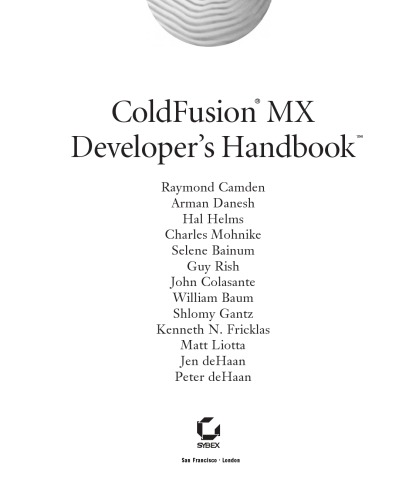

Most ebook files are in PDF format, so you can easily read them using various software such as Foxit Reader or directly on the Google Chrome browser.
Some ebook files are released by publishers in other formats such as .awz, .mobi, .epub, .fb2, etc. You may need to install specific software to read these formats on mobile/PC, such as Calibre.
Please read the tutorial at this link: https://ebookbell.com/faq
We offer FREE conversion to the popular formats you request; however, this may take some time. Therefore, right after payment, please email us, and we will try to provide the service as quickly as possible.
For some exceptional file formats or broken links (if any), please refrain from opening any disputes. Instead, email us first, and we will try to assist within a maximum of 6 hours.
EbookBell Team

4.8
84 reviews
ISBN 10: 0782140297
ISBN 13: 978-0782140293
Author: Raymond Camden; Arman Danesh; Hal Helms; Guy Rish; Emily Kim; Shlomy Gantz; Jen deHaan; Peter deHaan; Charles Mohnike; Selene Bainum; John Colasante; William Baum; Kenneth N. Fricklas; Matt Liotta
Part I: Managing Content and Applications.
Chapter 1: Designing and Planning a ColdFusion Application.
Chapter 2: Tr oubleshooting and Debugging ColdFusion MX Code.
Chapter 3: State Management in a Clustered Environment.
Chapter 4: The Fusebox Framework and Development Methodology.
Chapter 5: Developing Component-Based Applications.
Chapter 6: Creating Search Engines with Verity.
Chapter 7: Advanced WDDX.
Chapter 8: Application Security Techniques.
Chapter 9: Archives and Deployment.
Chapter 10: Source Code Management.
Part II: Advanced Database Integration.
Chapter 11: Advanced SQL.
Chapter 12: Stored Procedures.
Chapter 13: Upsizing Databases to SQL Server.
Part III: Client-Side Coding.
Chapter 14: Using JavaScript and DHTML with ColdFusion.
Chapter 15: Working with WAP and WML Clients.
Part IV: Enhancing Performance.
Chapter 16: Performance Tuning.
Chapter 17: Clustering:Load Balancing and Failover.
Chapter 18: Caching Techniques.
Part V: Custom Server-Side Coding.
Chapter 19: Working with Java Objects.
Chapter 20: Building Java Extensions.
Chapter 21: Building C++Extensions.
Chapter 22: Using cfexecute.
Part VI: Integrating with External Services.
Chapter 23: Integrating with Flash MX.
Chapter 24: Web Services.
Appendices.
Appendix A: Configuring ColdFusion for Java.
Appendix B: Understanding UML Class Diagrams.
Appendix C: Using the Code from This Book.
coldfusion 2021 tutorial
coldfusion 2021 documentation
adobe coldfusion programming language
coldfusion book pdf
coldfusion books
Tags: Raymond Camden, Arman Danesh, Hal Helms, Coldfusion